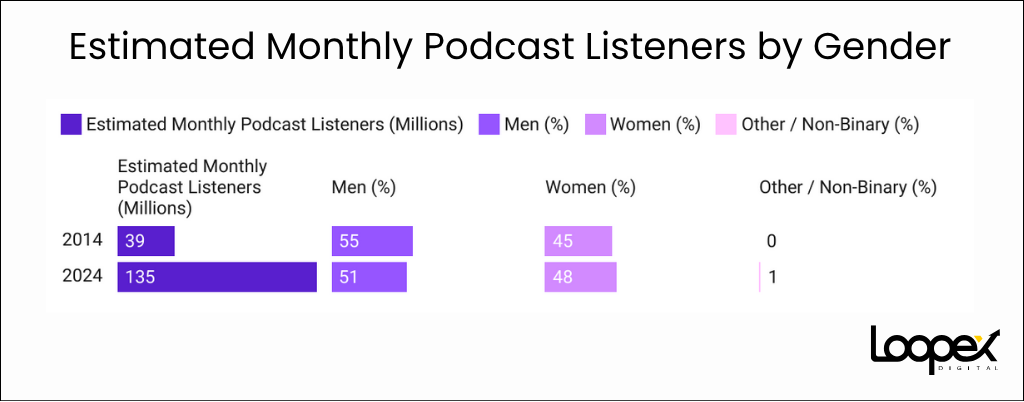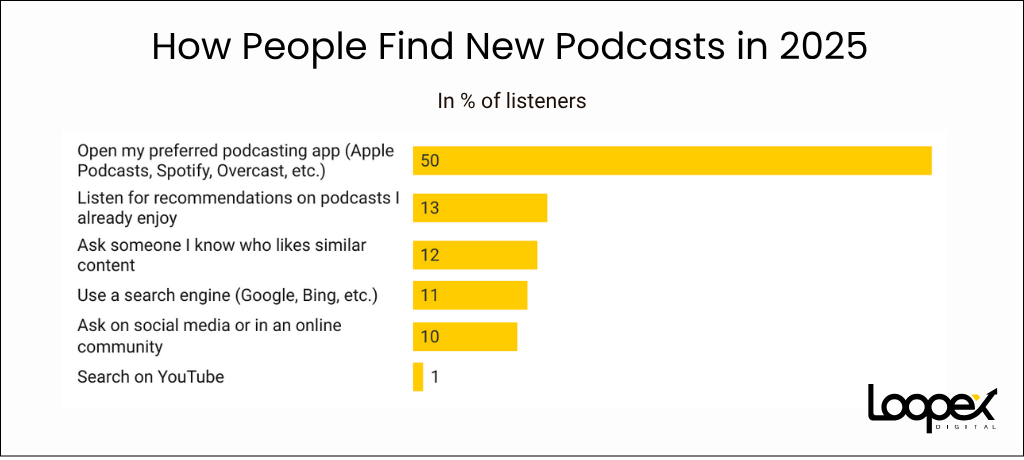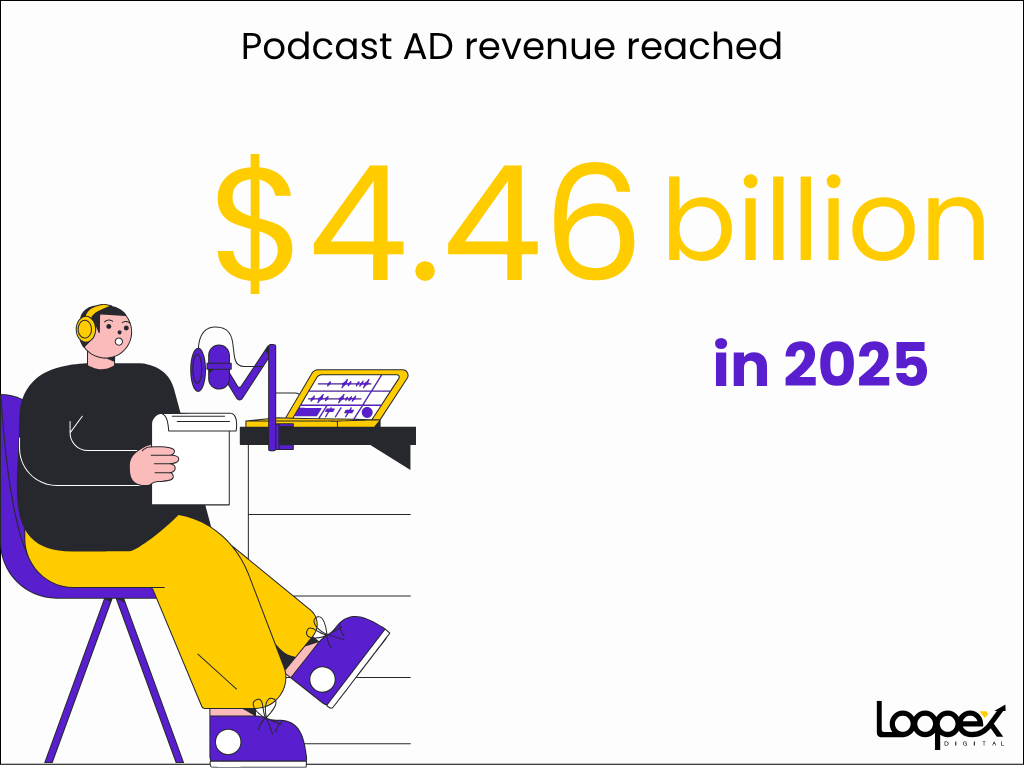Podcasting has matured in 2025. What started as an iPod-era niche has become a mainstream part of how people learn, relax, and buy. Growth has slowed from explosive to steady, but that’s a good thing: the audience is mature, and the money finally makes sense.
Between late 2024 and mid-2025, podcast ad spending from major brands jumped from $2 million to $6 million. Marketers now treat podcasts like any other paid channel, especially in DTC, fintech, and SaaS, where privacy-friendly, story-driven formats outperform cold ads.
Now, we’ll explore the podcast statistics of 2025 in more detail.
How to use these statistics:
We update this content every quarter to keep it fresh and relevant. All the current data reflects Q4 2025 industry reports and verified sources.
Podcasting is still growing, just not at the hyper-growth pace it saw a few years ago. The medium has matured, and that’s a healthy sign (Source):
That’s a steady 6-7% compound annual growth rate, the kind of curve you see when a platform becomes part of daily life.

Regional adoption image is also different:
Podcasting has gone truly global, but not in the way most people expect. The highest engagement comes from mobile-first markets rather than traditional media giants.
You’ve seen regional, now let’s see the top countries by weekly podcast listening (Source):

Let’s also explore the depth of engagement: how much longer does podcasting keep the audience hooked?
Podcast statistics clearly show that casual listening is over; podcast is a habit in 2025.
As of October 2025, there are about 4.52 million podcasts available worldwide across all platforms. That number includes everything ever published, even shows that stopped after a few episodes. In just the past three months, another 487,000 shows launched, proving that creator energy in podcasting remains high.
The big caveat: most of those millions aren’t active.
To count as an “active podcast,” industry standards (like those from Libsyn’s Rob Walch) require:
By that measure, only 345,000-391,000 podcasts are truly active, roughly 8-9% of all that exist. Todd Cochrane of Blubrry found a similar number when defining “active” as a show that’s published in the last 60 days (Source).
It’s also a consistency game: how often do those podcasts publish new episodes?

Moreover, nearly 44% end after just three episodes. For listeners, that means a cluttered landscape. For committed creators, it means a massive opportunity; showing up regularly is still the biggest differentiator.
For Creators:
With only 345K–391K active podcasts globally, the field is smaller than it looks. Consistency beats scale. Pick a focused niche, publish on schedule, and use the 7-day benchmark as your progress scorecard.
For Marketers:
Podcasts are definitely in demand. Add to that the fact that podcast ad spend hit $4.46B in 2025, up 27% year over year. In the U.S., it just passed $3B.
86% of heavy podcast listeners recall podcast ads, better than TV, YouTube, or social. Yet podcasts get only 3.8% of digital budgets.
So, invest early, partner long-term, and let hosts integrate your brand naturally. The ROI window is still open.

Podcasting has officially gone mainstream. What began as a youth-driven medium now reaches every age group, gender, and background, though age still predicts listening habits best.
Podcasting is strongest among younger listeners, but the older audience is catching up fast (Source):
.png)
That last number matters: older listeners bring higher incomes and stronger buying power. Among 18-29-year-olds, 67% have listened in the past year, roughly double the rate of those 65+ (33%) (Source). The gap is narrowing as older users discover podcasts through cars, smart speakers, and family recommendations.
The gender split is nearly even: 51% male, 48% female, 1% non-binary (Source).

Monthly listening skews slightly male (57% vs. 52%), but weekly engagement is rising fastest among women: 45% listened in the past week, up from 32% last year (Source).
Men are more likely to call themselves podcast fans (44% vs. 33% for women), but women represent a growing middle ground, already listening, just less attached. That’s a clear opportunity for creators to build stronger engagement with female audiences.
Podcast listeners are generally well-educated and employed (Source):
That profile (educated, employed, and digitally active) makes podcasts especially valuable for B2B marketers and premium brands targeting decision-makers and high-intent consumers.
Podcast fandom cuts evenly across racial groups, with fans making up 37-40% of each segment.
This diversification is reshaping the industry itself: more creators of color are launching shows that reflect their communities, languages, and lived experiences.
Podcasting is overwhelmingly mobile:
.png)
This mobile-first reality means creators should optimize audio for earbuds and phone speakers. Clean vocal mixing, tighter compression, and balanced levels matter more than studio polish.
Smart speakers and smart TVs are the least common devices for podcast consumption in the UK and the US (Source).
Podcast listening fits naturally into the day (Source):
The car leads all locations, with 38% of listeners tuning in while driving. Other hotspots include kitchens, gyms, and workplaces, anywhere people can listen while doing something else.
As Spotify notes, “60% of listeners use podcasts to learn, and two out of three say they give them full attention.”
Nearly half of all podcast downloads come from the U.S. (45.5%), followed by the UK (6.1%), Canada (4.7%), Australia (4.4%), and the Netherlands (3.4%) (Source).
English-speaking markets still dominate, but non-English podcasting is expanding fast as creators produce more local-language content.
The average podcast listener spends 6.3 hours per week with podcasts, up from 6.0 hours in 2024.
Heavy users go far beyond that; 80% listen for 7+ hours weekly, proving podcasts are a part of people’s routines.
Since 2015, total U.S. listening time has risen 355%, from 170 million to 773 million hours per week (Source). That’s one of the biggest shifts in modern media behavior.
Daily reach has climbed from 5% in 2014 to 18% in 2025, as podcasts weave into commutes, workouts, and bedtime routines.
Why people listen to podcasts in 2025 (Source):

Podcasts uniquely combine information, comfort, and companionship, a mix few other media can match.
For Creators
Publish on schedule, start strong, and design for multitasking ears to build habits and drive growth.
For Marketers
Approach podcast ads as long-term storytelling, partner with fitting hosts, and let authenticity drive the message before costs rise.
Each platform plays a different role in how audiences find, engage with, and stay loyal to podcasts.
U.S. podcasting platform share (Source):
YouTube now leads by a wide margin, driven by video-first habits and algorithmic discovery:
Its AI captions and auto-chapters make episodes searchable and shareable.
Here are the other dominant podcasting platforms in 2025 (Source):
The modern listener doesn’t pledge allegiance. More than half of YouTube listeners (53%) also follow the same shows elsewhere, and 73% say they’d switch platforms to keep up with a favorite podcast (Source).
The message is simple: no single platform owns the market.
Creators who distribute across all leading platforms capture reach, engagement, and retention in one ecosystem.
Video has become podcasting’s biggest format shift since RSS. What started as a niche experiment is now how millions discover new shows, and how platforms compete for attention.
All this proves that video marketing, in general, is reviving and leading in 2025 and beyond.
Still, it’s worth noting that audio-only episodes achieve 150% higher completion rates, while video dominates discovery.
.png)
For Creators:
Embrace video for discovery, but maintain a strong audio presence to keep your audience engaged until the end.
For Marketers:
Distribute your podcasts across all major platforms to capture the widest audience and boost engagement.
Listeners no longer find podcasts by scrolling through apps. In 2025, discovery happens across algorithms, search, and word of mouth (Source):
In terms of how the search for the podcasts happens, numbers and reasons look like this (Source):

According to recent surveys, those are the 11 key factors (Source):
If you’re a podcaster, keep the top 5 in mind for every episode.
Podcast engagement stays unmatched across digital media: average podcast shows have ~80% completion rate. This is good news for advertisers and marketers, since 90% is considered an excellent listen-through rate for podcasts, and 80% closer to that.
Podcast habits are consistent and deliberate (Source):
About 40% of podcast listeners consider themselves fans, not casuals. Engagement peaks among the 35-54 demographic: loyal, consistent, and high-income. Younger audiences explore more broadly but attach less deeply.
For Creators:
Focus on discoverability and consistency: optimize titles, descriptions, and SEO for search and YouTube, then publish predictably to build loyal, returning listeners.
For Marketers:
Podcasts deliver rare, high-attention environments, invest in storytelling placements that match the host’s trust, and reach audiences who actually finish what they start.

Podcast advertising has officially grown into a core digital channel, and the numbers back that:
Podcast ad spend continues to outpace most legacy formats: radio is declining, TV is flat, and display ads grow in low single digits. Only retail media (+14.8%) and connected TV (+15.4%) grow faster. (Source)
Context: Podcasts now account for 3.8% of total digital budgets, compared to video (22.6%) and search (15.5%); a small share, but with huge upside (Source):

Average first-quarter spend per new advertiser in 2025 was $42K. This number itself gives off the importance of podcasting in the 2025-2026 landscape.
There are five primary drivers:
Podcasting outperforms nearly every other medium on trust and follow-through (Source 1, Source 2):
Do you want a surprise podcast statistics insight?
Podcast hosts now rank just below friends (84%) and family (85%) in recommendation trust, a credibility tier no other ad channel achieves (Source).
Let’s look at the financial part of these podcast stats: how much does it cost to be advertised on a podcast episode (Source):
Host-read integrations command a 2-3× premium but outperform on recall, conversions, and authenticity. Listeners treat them as recommendations, not ads.
The recent market stats have uncovered an interesting comparative image of what ads for different media channels look like in comparison to podcasts (Source 1, Source 2):
Positioning: Podcast ads sit between TV’s emotional impact and digital’s measurability, but with far less competition.
For Creators:
Host-read ads drive the highest returns; keep them authentic, light, and woven naturally into your content.
For Marketers:
Podcast ads remain underused: invest early, go long-term with trusted hosts, and mix host-read with programmatic for scalable ROI.
Successful creators don’t rely on one source; they stack income streams. The primary revenue sources for podcasters include (Source):
What podcasters actually make depends on audience size, category, and engagement (Source):
CPMs by niche are also different:
.png)
Niche matters: a smaller, high-value audience often outperforms a large, passive one.
The top 1% dominate headlines:
But the real story is the rise of the middle class, thousands of creators earning $2-8K a month through a mix of ads, memberships, and services.
Mid-tier shows (5-50K downloads) now attract 70% of ad spending (Source). They deliver:
A niche show with loyal listeners can outperform a mass-market one with half-engaged followers.
For Creators:
The formula: small audience × strong trust × multiple income streams = sustainable business.
For Marketers:
Skip the mega-shows; partner with 5-10 mid-tier hosts where your message actually lands and converts.
AI is now part of the podcasting workflow:
Those numbers keep growing as new tools enter the market, with better capabilities for creators.
As of 2025, there are over 4.52 million podcasts available globally.
Only around 450,000 to 500,000 are actively publishing new episodes.
As of 2025, there are 2,267,422 podcasts in the United States.
584.1 million people globally are listening to podcasts in 2025.
The three major podcast platforms in 2025 are YouTube (39%), Spotify (21%), and Apple Podcasts (8%).
Our blog covers a combination of industry trends and professional insights from behind-the-scenes experiences. We provide weekly updates on link building, content marketing, on-site and technical SEO, and more! Sign up for our newsletter and join our LinkedIn to be on top of industry trends!
Submit the form - Get Free Proposal
%202.png)
24 hours

Submit the form - Get Free Proposal
%202.png)
24 hours